
The index page for the 1954 French flap section of this website is here.
Reference for this case: 6-Oct-54-Morcourt.
Please cite this reference in any correspondence with me regarding this case.
The regional newspaper La Voix du Nord, in its issue of the Aisne for October 9, 1954, reported an observation dated, perhaps, "Wednesday" therefore October 6, 1954:
Seven people from Morcourt, 4 kilometers from Saint-Quentin, had noticed, around 8:30 p.m., in a north-west direction, a ball of fire, which oscillated and moved slowly from left to right, rising and falling, to finally disappear.
Two of the witnesses were very categorical: MM. Levert, gardener, and Trannois son, P.T.T. mailman, in Saint-Quentin.
The newspaper explains that they did not claim to have seen a flying saucer, because according to them, it was a luminous phenomenon, with various colors, ranging from purple to red, passing through white, which had lasted about twenty minutes.
They had absolutely agreed with the meteorologists of the Roupy station, who, consulted on the morning of October 5, 1954 on the sighting, had explained to the newspaper that it was a paraselene, a reflection of the Moon caused by a cloud of ice crystals.
In the newspaper L'Aisne Nouvelle of the same October 9, 1954, the meteorologists of the Roupy station gave more detailed explanations on the phenomenon of paraselene.
[Ref. vdn1:] NEWSPAPER "LA VOIX DU NORD":
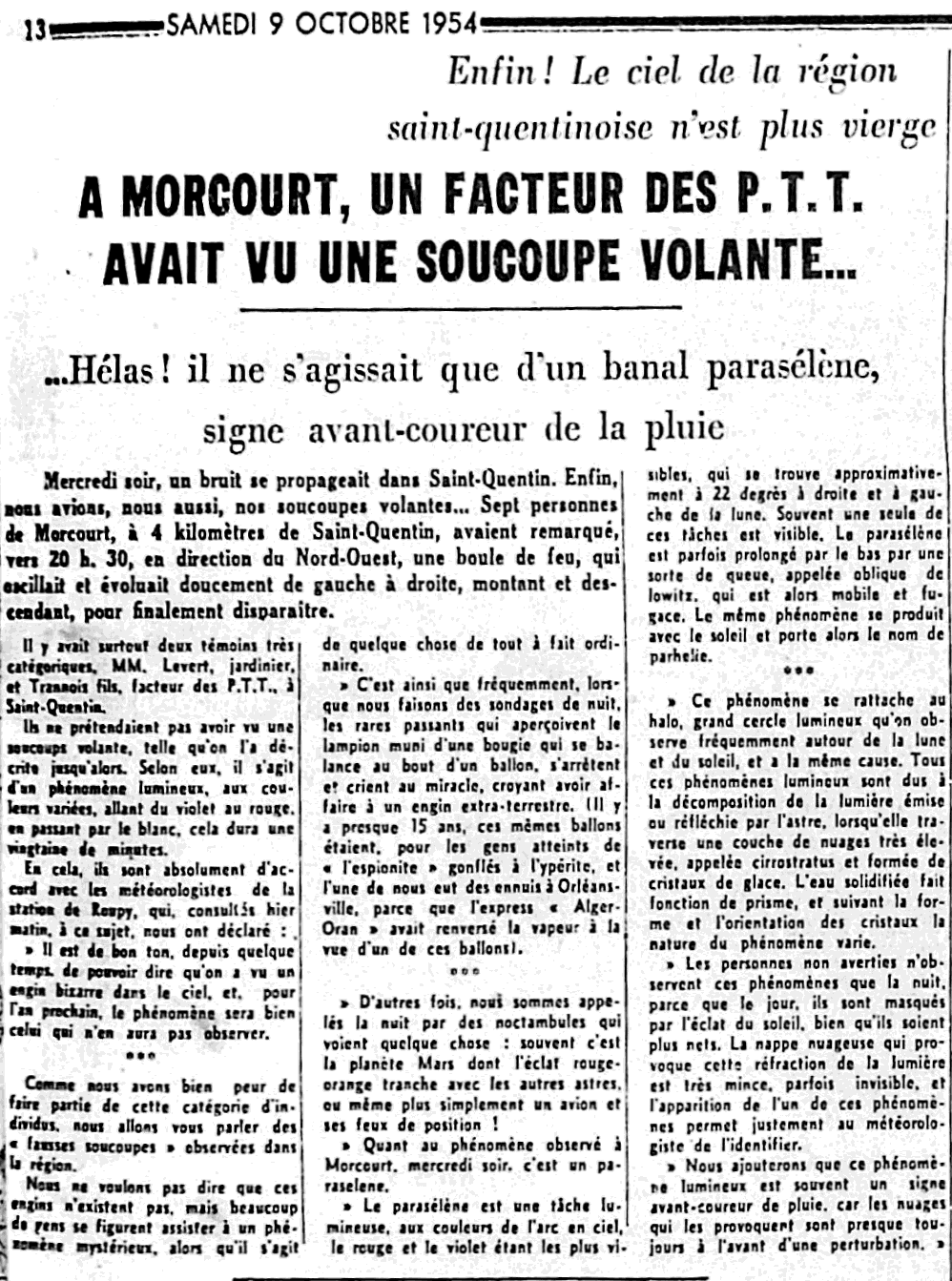
|
On Wednesday evening, a noise spread in Saint-Quentin. Finally, we also had our flying saucers... Seven people from Mercourt, 4 kilometers from Saint-Quentin, had noticed, around 8:30 p.m., in a north-westerly direction, a ball of fire, which oscillated and moved slowly from left to right, ascending and descending, to finally disappear.
There were above all two very categorical witnesses, MM. Levert, gardener, and Trannois fils, P.T.T. mailman, in Saint-Quentin.
They did not claim to have seen a flying saucer, as it has been described until then. According to them, it is a luminous phenomenon, with varied colors, ranging from purple to red, passing through white, it lasted about twenty minutes.
In this, they absolutely agree with the meteorologists of the Roupy station, who, consulted yesterday morning, on this matter, told us:
"It has been fashionable, for some time, to be able to say that one saw a strange craft in the sky, and, for next year, the phenomenon will be the one who did not observe one.
* * *
As we are afraid to be part of this category of individuals, we are going to tell you about the "false saucers" observed in the region.
We don't mean to say that these craft do not exist, but many people imagine they are witnessing a mysterious phenomenon, when it is quite ordinary.
"This is how frequently, when we do night polls, the few passers-by who see the lantern with a candle swinging at the end of a balloon, stop and cry out a miracle, believing to deal with an extraterrestrial craft. Almost 15 years ago, those same balloons were, for people with "spyitis" inflated with mustard gas, and one of us got in trouble in Orléansville, because the "Algiers-Oran" express had eversed its route at the sight of one of these balloons!.
"Other times, we are called at night by night owls who see something: often it is the planet Mars whose red orange glow contrasts with the other stars, or even more simply an airplane and its navigation lights!
"As for the phenomenon observed in Mortcourt, Wednesday evening, it is a paraelene.
"The paraselene is a bright, rainbow-colored spot, red and purple being the most noticeable, which is approximately 22° to the right and left of the moon. Often only one of these spots is visible. The paraselene is sometimes extended from below by a sort of tail, called the oblique of lowitz, which is then mobile and fleeting. The same phenomenon occurs with the sun and is then called parhelion.
* * *
"This phenomenon is related to the halo, a large luminous circle that is frequently observed around the moon and the sun, and has the same cause. All these luminous phenomena are due to the decomposition of the light emitted or reflected by the star, when it crosses a very high layer of clouds, called cirrostratus and formed of ice crystals. The solidified water acts as a prism, and depending on the shape and orientation of the crystals the nature of the phenomenon varies.
"Uninformed people only observe these phenomena at night, because during the day they are obscured by the glare of the sun, although they are sharper. The cloud layer that causes this refraction of light is very thin, sometimes invisible, and the appearance of one of these phenomena allows meteorologists to identify it.
"We will add that this luminous phenomenon is often a harbinger of rain, because the clouds that cause them are almost always in front of a disturbance."
[Ref. ane1:] NEWSPAPER "L'AISNE NOUVELLE":
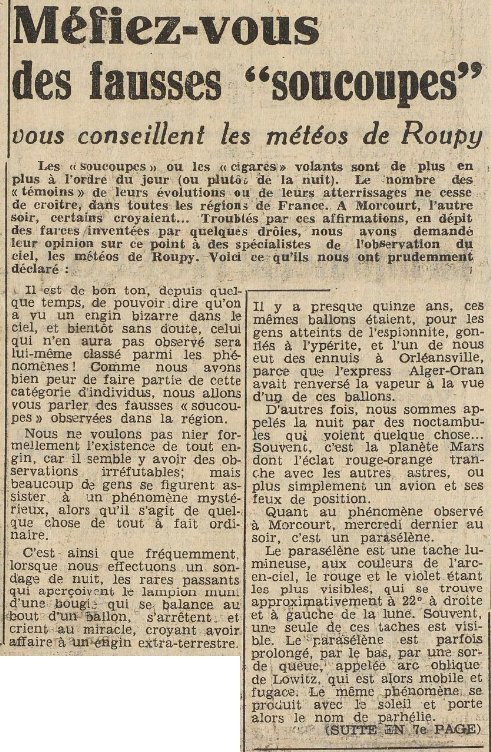
|
"Saucers" or flying "cigars" are increasingly in the news (or rather, in the night). The number of "witnesses" to their movements or landings continues to grow across all regions of France. In Morcourt the other evening, some believed... Troubled by these claims - despite the hoaxes invented by a few pranksters - we asked for the opinion of sky-observation specialists, the meteorologists of Roupy. Here is what they cautiously told us:
It has become fashionable recently to say that one has seen a strange object in the sky, and soon, no doubt, those who haven't will themselves be considered phenomena! As we are afraid we might belong to that category, we will tell you about the fake "saucers" observed in the region.
We don't want to categorically deny the existence of every such craft, as some sightings seem irrefutable; but many people believe they are witnessing a mysterious phenomenon when in fact it's something entirely ordinary.
For example, when we conduct a night-time weather balloon launch, the rare passersby who spot the lantern with a candle swaying at the end of the balloon stop and shout in amazement, thinking they're seeing an extraterrestrial craft.
Nearly 15 years ago, those same balloons were, for people suffering from "spy fever," imagined to be filled with mustard gas, and one of us had trouble in Orléansville because the Algiers-Oran express train reversed course upon seeing one of them.
Other times, we're called in the middle of the night by night owls who see something... Often, it's the planet Mars, whose reddish-orange glow stands out from the other stars - or more simply, an airplane and its navigation lights.
As for the phenomenon observed in Morcourt last Wednesday evening, it was a paraselene.
A paraselene is a luminous spot with the colors of a rainbow - red and violet being the most visible - that appears roughly 22° to the right and left of the moon. Often, only one of these spots is visible. The paraselene is sometimes extended downward by a sort of tail, called a Lowitz arc, which is mobile and fleeting. The same phenomenon occurs with the sun and is then called a parhelion.
(CONTINUED ON PAGE 7)
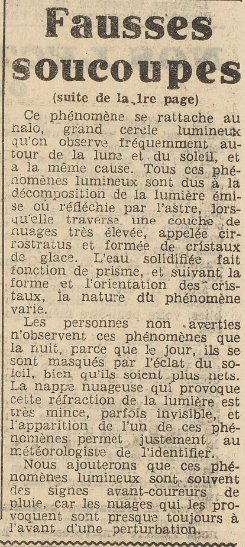
|
(Continued from page 1)
This phenomenon is related to the halo - the large luminous circle often seen around the moon and the sun - and has the same cause. All these luminous phenomena are due to the decomposition of light emitted or reflected by the celestial body as it passes through a very high cloud layer called cirrostratus, which is made up of ice crystals. The solidified water acts like a prism, and depending on the shape and orientation of the crystals, the nature of the phenomena varies.
Uninformed observers only notice these phenomena at night, because during the day they are masked by the sun's brightness, even though they are actually clearer. The cloud layer that causes this light refraction is very thin - sometimes invisible - and the appearance of one of these phenomena helps meteorologists identify it.
We will add that these luminous phenomena are often early signs of rain, as the clouds that cause them almost always precede a weather disturbance.
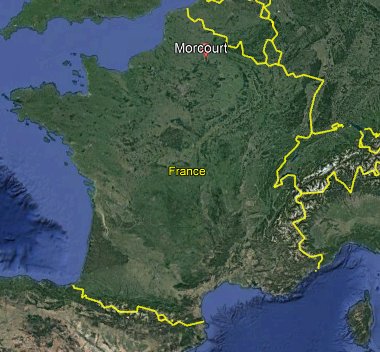
|
A priori: negative case, Moondog.
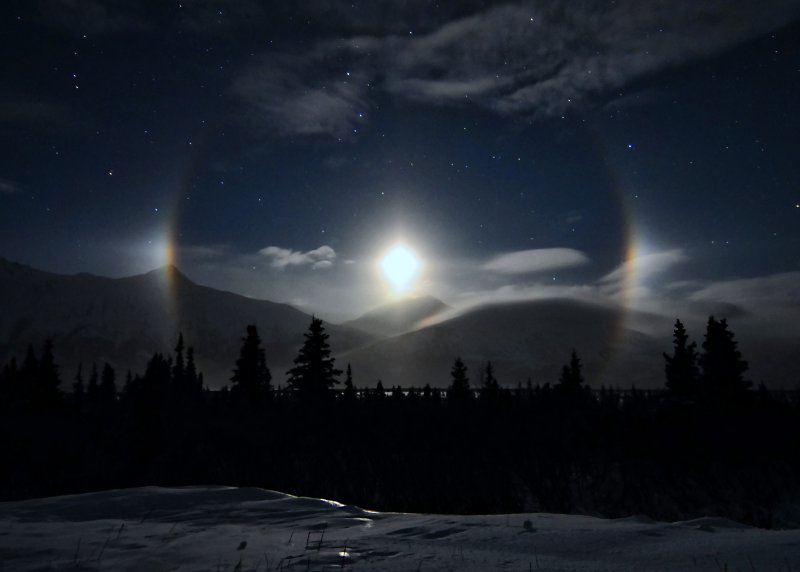
|
But I nevertheless did check the visibility of the Moon. On October 6, 1954 at 8:30 p.m. from Morcourt, it was in the sky, direction 187°, elevation 20°.
It was therefore in fact due South (The Moon is never towards the North seen from France, obviously), it is therefore a little surprising that the newspaper writes that the phenomenon was in the northwest... Newspaper error, witnesses error? Or clue that it was not a Moondog after all? The description may also be in error, but does not look like a description of a Moondog.
To the Nortwest, there was no remarkable astronomical body in the sky; the most intersting was the star Arcturus, elevatin 10°, direction 287°, that is, more West-North-West than Northwest.
(These keywords are only to help queries and are not implying anything.)
Morcourt, Aisne, night, multiple, ball, fire, oscillation, ascent, descent, Levert, gardener, Trannois, mailman, luminous, colors, purple, red, white, duration
[----] indicates sources that are not yet available to me.
| Version: | Created/Changed by: | Date: | Change Description: |
|---|---|---|---|
| 1.0 | Patrick Gross | October 25, 2021 | First published. |
| 1.1 | Patrick Gross | May 8, 2025 | Addition [ane1]. In the Summary, addition of the paragraph "In the newspaper..." |